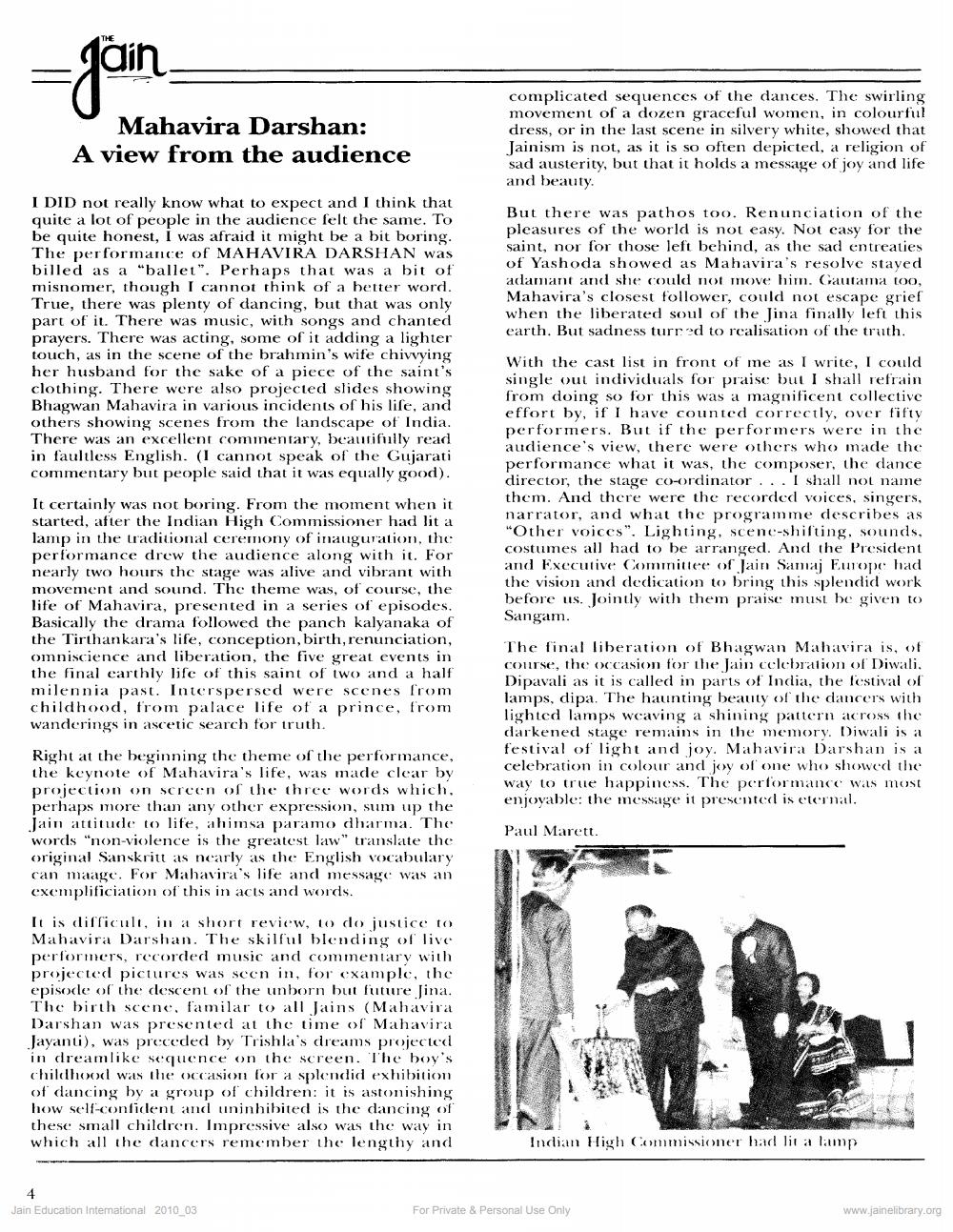Book Title: The Jain 1992 04 Special Issue Author(s): Natubhai Shah, Vinod Kapashi Publisher: UK Jain Samaj Europe View full book textPage 4
________________ -Jain. Mahavira Darshan: A view from the audience complicated sequences of the dances. The swirling movement of a dozen graceful women, in colourful dress, or in the last scene in silvery white, showed that Jainism is not, as it is so often depicted, a religion of sad austerity, but that it holds a message of joy and life and beauty But there was pathos too. Renunciation of the pleasures of the world is not easy. Not easy for the saint, nor for those left behind, as the sad entreaties of Yashoda showed as Mahavira's resolve stayed adamant and she could not move him. Gautama too, Mahavira's closest follower, could not escape grief when the liberated soul of the Jina finally left this earth. But sadness turned to realisation of the truth. I DID not really know what to expect and I think that quite a lot of people in the audience felt the same. To be quite honest, I was afraid it might be a bit boring. The performance of MAHAVIRA DARSHAN was billed as a "ballet". Perhaps that was a bit of misnomer, though I cannot think of a better word. True, there was plenty of dancing, but that was only part of it. There was music, with songs and chanted prayers. There was acting, some of it adding a lighter touch, as in the scene of the brahmin's wife chivvying her husband for the sake of a piece of the saint's clothing. There were also projected slides showing Bhagwan Mahavira in various incidents of his life, and others showing scenes from the landscape of India. There was an excellent cominentary, beautifully read in faultless English. (I cannot speak of the Gujarati commentary but people said that it was equally good). It certainly was not boring. From the moment when it started, after the Indian High Commissioner had lit a lamp in the traditional ceremony of inauguration, the performance drew the audience along with it. For nearly two hours the stage was alive and vibrant with movement and sound. The theme was, of course, the life of Mahavira, presented in a series of episodes. Basically the drama followed the panch kalyanaka of the Tirthankara's life, conception, birth, renunciation, omniscience and liberation, the five great events in the final earthly life of this saint of two and a half milennia past. Interspersed were scenes from childhood, from palace life of a prince, from wanderings in ascetic search for truth. With the cast list in front of me as I write, I could single out individuals for praise but I shall refrain from doing so for this was a magnificent collective effort by, if I have counted correctly, over fifty performers. But if the performers were in the audience's view, there were others who made the performance what it was, the composer, the dance director, the stage co-ordinator... I shall not name them. And there were the recorded voices, singers, narrator, and what the programme describes as "Other voices". Lighting, scene-shifting. sounds, costumes all had to be arranged. And the President and Executive Committee of Jain Samaj Europe had the vision and dedication to bring this splendid work before us. Jointly with them praise must be given to Sangam. The final liberation of Bhagwan Mahavira is, of course, the occasion for the Jain celebration of Diwali, Dipavali as it is called in parts of India, the festival of lamps, dipa. The haunting beauty of the dancers with lighted lamps weaving a shining pattern across the darkened stage remains in the memory Diwali is a festival of light and joy. Mahavira Darshan is a celebration in colour and joy of one who showed the way to true happiness. The performance was most enjoyable: the message it presenteel is eternal. Paul Marett. Right at the beginning the theme of the performance, the keynote of Mahavira's life, was made clear by projection on screen of the three words which perhaps more than any other expression, sum up the Jain attitude to life, ahimsa paramo dharma. The words "non-violence is the greatest law" translate the original Sanskritt as nearly as the English vocabulary can maage. For Mahavira's life and message was an exemplification of this in acts and words. It is difficult, in a short review, to do justice to Mahavira Darshan. The skilful blending of live performers, recorded music and commentary with projected pictures was seen in, for example, the episode of the descent of the unborn but future Jina. The birth scene, familar to all Jains (Mahavira Darshan was presented at the time of Mahavira Jayanti), was preceded by Trishla's dreams projected in dreamlike sequence on the screen. The boy's childhood was the occasion for a splendid exhibition of dancing by a group of children: it is astonishing how self-confident and uninhibited is the dancing of these small children. Impressive also was the way in which all the dancers remember the lengthy and Indian High Commissioner had lita lamp Jain Education International 2010_03 For Private & Personal Use Only www.jainelibrary.orgPage Navigation
1 2 3 4 5 6 7 8 9 10 11 12 13 14 15 16 17 18 19 20 21 22 23 24 25 26 27 28 29 30 31 32 33 34 35 36 37 38 39 40 41 42 ... 68
